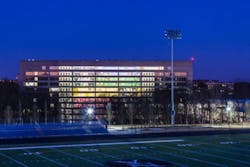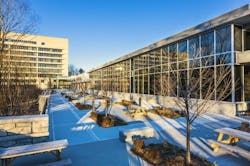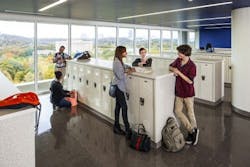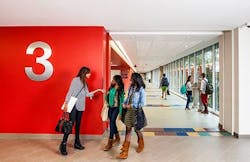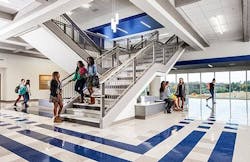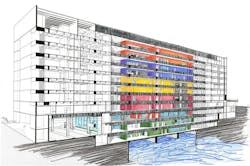Extreme conversion: Atlanta turns high-rise office building into high school
With an 11-story former IBM office building, a 9-story annex, and 56 acres of land, architecture firm Cooper Carry created a new high school for 2,350 students in north Atlanta.
The centerpiece of the school is the 11-story Lakeside building, which was originally built in 1977 by Thompson, Ventulett, Stainback & Associates. The building now houses administrative offices, a media center, a cafeteria, and academic classrooms, according to ArtsATL.
The existing parking deck remains, though the parking lots adjacent to the annex building were made into sports fields. The Building Team, which also included Collins Cooper Carusi Architects and Paul Cheeks Architects, decided to demolish the annex and build a new structure to house a 600-seat main theater, a black box theater, music rooms, a 2,100-seat gym, and an auxiliary gym.
Although the Lakeside building retains many signs of its original purpose, like the spacious main lobby with its large columns and retro spiral staircase, the glassed-in main office makes the building's new status as a school clear. The design team played on the building's strengths, especially the floor-to-ceiling windows, which give students and teachers breathtaking views of the forested surroundings. From inside the building, one can see over the treetops to the high-rises around the Cobb Galleria on one side; on the other, they can see downtown Atlanta, Midtown, and Buckhead.
The school's interior is in large part dictated by Atlanta Public Schools' requirements for construction materials, according to ArtsATL. Linoleum floors, stainless steel railings, and drop ceilings are consistent throughout. However, Cooper Carry did play with the color palette and added custom details.
Each grade occupies two stories connected by one large stairway. With a signature color for each grade, visitors can immediately determine where they are in the building. In the central spaces, some of the concrete structure remains exposed and special lights highlight some of the building's architectural features.
The new Hillside building is only two stories, but it stretches over horizontally for over 400 feet. To link the buildings with the parking deck, the architects conceived "Warrior Way," named as an homage to the school's mascot. This low building begins at the parking deck, so when students either drive up or are dropped off, they can immediately go inside. Warrior Way connects the cafeteria in the Lakeside building to the auditorium, gymnasium, and bus drop-off loop at the far end of the Hillside building. In this way, it provides a central axis for the campus. It provides views of the lake between the two buildings, and an outdoor plaza can be accessed from Warrior Way as well.
Here is a photo walkthrough of the building:

